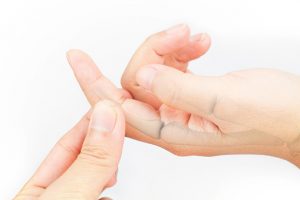
Causes and risk factors of heberden’s node
Heberden’s nodes have a direct correlation with osteoarthritis, a degenerative bone disease that typically affects the spine, knees, hips or fingers. In this condition, joints usually cushioned by spongy cartilage on the bone surface become worn out due to constant use. Osteoarthrosis is a disease that comes with aging, and years of wear-and-tear on the joints can lead to the condition. Also, injury to a particular joint can lead to the premature development of osteoarthrosis in that joint.
This degenerative joint condition can cause the bones in the hand to swell and develop a general crookedness of the finger joints as the cartilage wears away. This process strips the finger joints of their protection, allowing for bone on bone contact. When this occurs, it destroys the existing bone and leads to significant pain as the bones begin to rub together. New bone formation occurs as a result of this increased stress on the finger joints, which grow alongside existing bone forming nodes. When fully formed, nodes are present, and the patients often have stiff restricting movement, a sign of advanced osteoarthritis.
Heberden’s node symptoms
The presence of heberden nodes signifies that severe osteoarthritis is present. When viewed up close, the finger may appear twisted or crooked due to node formation. Tiny bone outgrowths may extend from the knuckle closest to the fingernail. It is important to note that due to the advanced nature and restricted moment caused by heberden’s nodes on the finger, a patient may not complain of any symptoms, as they have learned not to overuse the hands over time. The following are expected symptoms of heberden’s nodes:
- Reduced range of motion
- Pain
- Swelling
- Stiffness at the location of the node
Treating heberden’s node
Unfortunately, heberden’s nodes are part of osteoarthritis, which his incurable. Symptomatic treatment is the only effective treatment for this condition, which involves pain relief and joint function restoration if possible. Treatment will likely depend on the patient’s own personal medical history and current medication. The following are some of the most widely used treatment methods proved to help osteoarthritis patients.
Lifestyle changes: Exercise is considered one of the most effective treatments for osteoarthritis, as physical activity helps reduce pain and improve strength and flexibility. It is important to see a doctor first to gauge the level of exercise appropriate for you, as osteoarthritis patients may fall easily and are prone to bone fractures. Occupational therapy or physical therapy may also help increase the range of motion and control pain. Losing excess weight will also reduce unnecessary stress on weight bearing joints.
Medications: The most common medication utilized in osteoarthritis patients are non-steroidal anti-inflammatory drugs, or NSAIDs. They help relieve pain and reduce inflammation that can occur in joints with minimal side effects. It is important to note that chronic NSAIDs use has been associated with heart failure, kidney damage, and intestinal bleeding. Examples of NSAIDs include Advil (ibuprofen) and naproxen.
Surgery: When lifestyle change and medication use is not sufficient, the only solution is surgical intervention. Surgery is often considered the last resort for treatment of osteoarthritis. This may include joint reconstruction or the removal of bone growths.